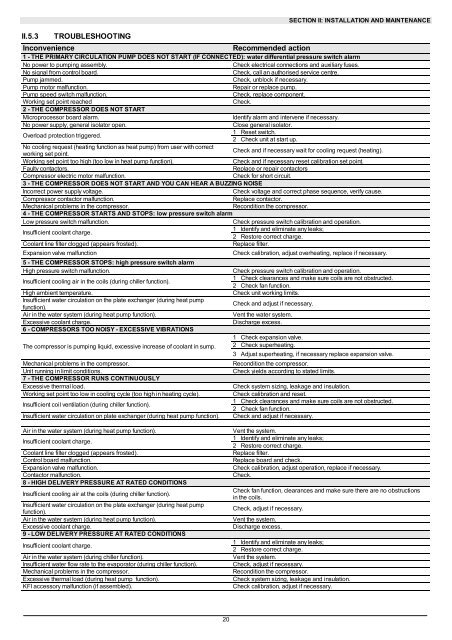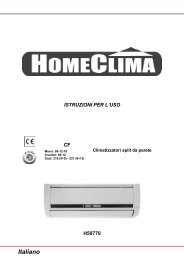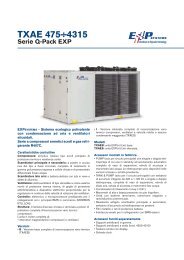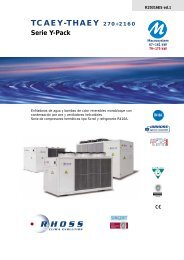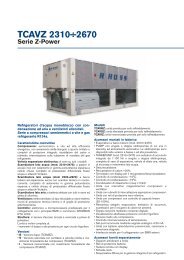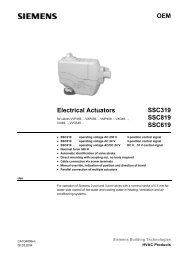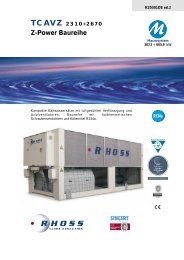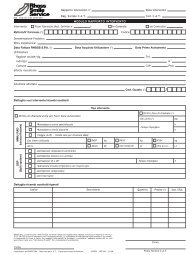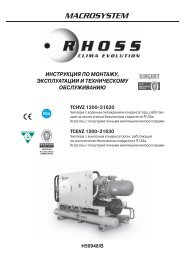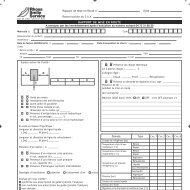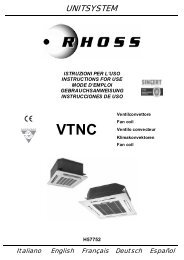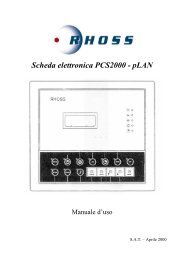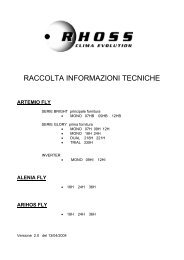tcaes 230÷4160 thae - Rhoss
tcaes 230÷4160 thae - Rhoss
tcaes 230÷4160 thae - Rhoss
You also want an ePaper? Increase the reach of your titles
YUMPU automatically turns print PDFs into web optimized ePapers that Google loves.
II.5.3<br />
TROUBLESHOOTING<br />
SECTION II: INSTALLATION AND MAINTENANCE<br />
Inconvenience<br />
Recommended action<br />
1 - THE PRIMARY CIRCULATION PUMP DOES NOT START (IF CONNECTED): water differential pressure switch alarm<br />
No power to pumping assembly.<br />
Check electrical connections and auxiliary fuses.<br />
No signal from control board.<br />
Check, call an authorised service centre.<br />
Pump jammed.<br />
Check, unblock if necessary.<br />
Pump motor malfunction.<br />
Repair or replace pump.<br />
Pump speed switch malfunction.<br />
Check, replace component.<br />
Working set point reached<br />
Check.<br />
2 - THE COMPRESSOR DOES NOT START<br />
Microprocessor board alarm.<br />
Identify alarm and intervene if necessary.<br />
No power supply, general isolator open.<br />
Close general isolator.<br />
Overload protection triggered.<br />
1 Reset switch.<br />
2 Check unit at start up.<br />
No cooling request (heating function as heat pump) from user with correct<br />
working set point.<br />
Check and if necessary wait for cooling request (heating).<br />
Working set point too high (too low in heat pump function).<br />
Check and if necessary reset calibration set point.<br />
Faulty contactors.<br />
Replace or repair contactors<br />
Compressor electric motor malfunction.<br />
Check for short circuit.<br />
3 - THE COMPRESSOR DOES NOT START AND YOU CAN HEAR A BUZZING NOISE<br />
Incorrect power supply voltage.<br />
Check voltage and correct phase sequence, verify cause.<br />
Compressor contactor malfunction.<br />
Replace contactor.<br />
Mechanical problems in the compressor.<br />
Recondition the compressor.<br />
4 - THE COMPRESSOR STARTS AND STOPS: low pressure switch alarm<br />
Low pressure switch malfunction.<br />
Check pressure switch calibration and operation.<br />
Insufficient coolant charge.<br />
1 Identify and eliminate any leaks;<br />
2 Restore correct charge.<br />
Coolant line filter clogged (appears frosted).<br />
Replace filter.<br />
Expansion valve malfunction<br />
5 - THE COMPRESSOR STOPS: high pressure switch alarm<br />
High pressure switch malfunction.<br />
Insufficient cooling air in the coils (during chiller function).<br />
High ambient temperature.<br />
Insufficient water circulation on the plate exchanger (during heat pump<br />
function).<br />
Air in the water system (during heat pump function).<br />
Excessive coolant charge.<br />
6 - COMPRESSORS TOO NOISY - EXCESSIVE VIBRATIONS<br />
The compressor is pumping liquid, excessive increase of coolant in sump.<br />
Mechanical problems in the compressor.<br />
Unit running in limit conditions.<br />
7 - THE COMPRESSOR RUNS CONTINUOUSLY<br />
Excessive thermal load.<br />
Working set point too low in cooling cycle (too high in heating cycle).<br />
Insufficient coil ventilation (during chiller function).<br />
Insufficient water circulation on plate exchanger (during heat pump function).<br />
Check calibration, adjust overheating, replace if necessary.<br />
Check pressure switch calibration and operation.<br />
1 Check clearances and make sure coils are not obstructed.<br />
2 Check fan function.<br />
Check unit working limits.<br />
Check and adjust if necessary.<br />
Vent the water system.<br />
Discharge excess.<br />
1 Check expansion valve.<br />
2 Check superheating.<br />
3 Adjust superheating, if necessary replace expansion valve.<br />
Recondition the compressor.<br />
Check yields according to stated limits.<br />
Check system sizing, leakage and insulation.<br />
Check calibration and reset.<br />
1 Check clearances and make sure coils are not obstructed.<br />
2 Check fan function.<br />
Check and adjust if necessary.<br />
Air in the water system (during heat pump function).<br />
Insufficient coolant charge.<br />
Coolant line filter clogged (appears frosted).<br />
Control board malfunction.<br />
Expansion valve malfunction.<br />
Contactor malfunction.<br />
8 - HIGH DELIVERY PRESSURE AT RATED CONDITIONS<br />
Insufficient cooling air at the coils (during chiller function).<br />
Insufficient water circulation on the plate exchanger (during heat pump<br />
function).<br />
Air in the water system (during heat pump function).<br />
Excessive coolant charge.<br />
9 - LOW DELIVERY PRESSURE AT RATED CONDITIONS<br />
Insufficient coolant charge.<br />
Air in the water system (during chiller function).<br />
Insufficient water flow rate to the evaporator (during chiller function).<br />
Mechanical problems in the compressor.<br />
Excessive thermal load (during heat pump function).<br />
KFI accessory malfunction (if assembled).<br />
Vent the system.<br />
1 Identify and eliminate any leaks;<br />
2 Restore correct charge.<br />
Replace filter.<br />
Replace board and check.<br />
Check calibration, adjust operation, replace if necessary.<br />
Check.<br />
Check fan function, clearances and make sure there are no obstructions<br />
in the coils.<br />
Check, adjust if necessary.<br />
Vent the system.<br />
Discharge excess.<br />
1 Identify and eliminate any leaks;<br />
2 Restore correct charge.<br />
Vent the system.<br />
Check, adjust if necessary.<br />
Recondition the compressor.<br />
Check system sizing, leakage and insulation.<br />
Check calibration, adjust if necessary.<br />
20


